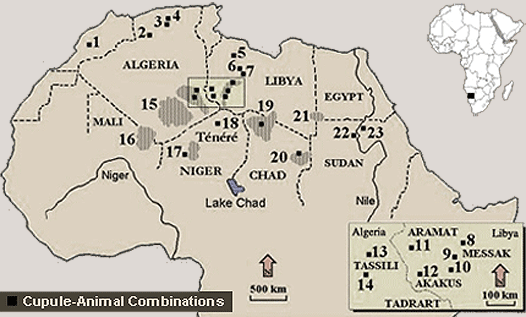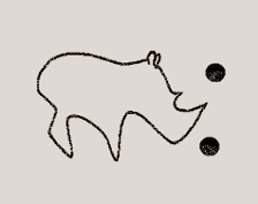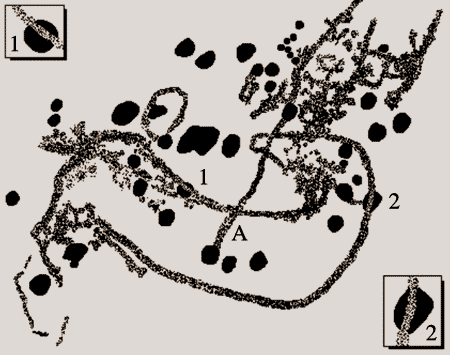 |
 |
TWYFELFONTEIN CUPULES |
1/8 |
In
Part 1 we have seen that there are many combinations of cupules and animal engravings at Twyfelfontein. The meaning of these combinations is still completely obscure; it is even uncertain if a relation exists. This Part attempts to clarify the possible relationships between cupules and animal imagery in general by examining several analogies throughout the world.
In a directional relationship between those two elements, three alternatives may be distinguished. The first is based on the general possibility that cupules are earlier and that the animal art was added later. In that case the original meaning of the cupules may have nothing to do with the symbolism of the animal imagery. It is rather well possible however that the presence of the cupules was the reason for selecting the rock for animal imagery and then the cupules may have been invested with a new symbolism.
The second option is that cupules were simultaneously executed by the same "hand", often as an integral part of the animal imagery and expressing a special (functional and/or symbolical) relationship between animal and cupule that would be explicable within the cultural matrix.
The third alternative is that cupules are secondary and that they were added to panels that already had been engraved with animals. In this case, there may also be a special relationship between cupules and the animal engravings, or, importantly, with the stone on which those animals were carved, or even with the site itself.
It will sometimes be very hard (or impossible) to allocate certain examples into one of the three groups. For instance, an animal may have been engraved around an existing cupule, intentionally included to represent the eye of the animal (at Twyfelfontein, Scherz [1975: 180] reports a zebra on stone C6a that has been engraved around a natural projection of rock now representing [possibly intentionally] the eye). Such a cupule may easily but erroneously be interpreted as belonging to the second or even third category. But it is also possible that a cupule was indeed added much later as an eye to an existing animal (as possibly is the case with a cupule for a second eye at an elephant engraving from Libya: Coulson & Campbell 2001: 180) and that the cupule is erroneously allocated into the second category.
Anyhow, on a global scale there are many instances where cupules seem to form an integral (primary or secondary) part of iconic imagery. Such cupules may look insignificant in first instance. However, they may constitute an important expression of certain prehistoric beliefs after all. But how can we access the meaning of those seemingly insignificant rock-art elements? A major problem at Twyfelfontein, and indeed elsewhere, is that any informed knowledge of the reasons to execute cupules does not exist. Therefore, one heavily depends on formal methods, especially analogies, although such methods may easily cause misinterpretations.
Unfortunately, many publications about iconic rock-art seem to ignore the presence of cupules. Especially when the cupule forms just a small fragment within a frame of sometimes overwhelming (more important?) iconic imagery, its presence (and importance) seems to be overlooked. Often cupules are not even mentioned (for instance at Coulson & Campbell 2001: Fig. 182). In many instances drawings of rock-art imagery are published featuring elements that look like cupules, but an explanatory text to reveal the character of the possible depression(s) is often lacking (for instance Soleilhavoup 2000: Fig. 9; Coulson & Campbell 2001: Fig. 47). It sometimes seems as if the cupule is regarded as an "inferior" or possibly only decorative element within iconic rock-art, as if it does not seem to convey any specific message.
Figure 42
Click for Enlargement
Figure 39
Click for Enlargement
Even when cupules are specifically mentioned in literature, other problems may arise, such as incomplete or even conflicting information. An example will illustrate the latter possibility. At Luine, Valcamonica, Italy, rock panel 34-A is decorated with an alleged anthropomorphous figure (about 2m tall), one smaller deer and many apparently randomly distributed cupules. Anati (1999: 7), describing and illustrating only the animal and cupules, states that the deer is "struck by arrows" and that "the numerous cup-marks were added later". Flowing from this description, it looks as if the cupules were associated only with an already existing deer engraving.
However, it is rather confusing that in an earlier description of the whole panel (Anati 1982: 102) there is no mention of arrows. Moreover, the line that seemingly pierces the deer as an arrow (A in
Figure 37) is in fact part of the alleged anthropomorph. The cupules also prove to be distributed all over the panel and not only near the animal engraving. Earlier Anati (1982) stated that the deer represents the oldest stage on the panel, followed by the anthropomorph and that the cupules were added later still, in some cases superimposing the anthropomorph.
Anati's illustrations suggest however, that the grooves that make up the animal's outline have been drawn upon two cupules (1 and 2 in
Figure 37). The Luine deer therefore seems to have been superimposed upon the cupules. If this is true, the deer is more likely to be later and this would mean that the cupules represent the earliest stage of engraving at this panel.
The main issue is now that the interpretation of the meaning of the cupule in any cupule-animal combination also heavily depends on the relative chronology of the two elements and thus on a very careful recording. Unfortunately, absolute dates for cupules (and for other engravings as well!) are almost always lacking, so no help from this discipline can be expected. Even approximate relative dating (let alone precise absolute dating) is notoriously difficult, especially when there is no question of a clear case of superimposition.
To give an example. Huard & Leclant (1980b: 325) describe an engraving of a rhinoceros incised on a rock at Aïn Naga, Algeria (Site 4 in Figure 39 see below). In front of the animal (
Figure 42 B) are two deep cupules, said to date from the same period, although, unfortunately, it is not stated from which period. The problem here is that an art style period can be rather long. Let us assume for instance, that the rhinoceros and the two cupules can both be ascribed to the so-called Bubalus Period (one of the earliest Saharan art periods depicting animals, roughly dating from 12.000 to 8000 BP). This enormous time span allows for the execution of the cupules and the incision of the rhinoceros to have taken place centuries apart.

Figure 39
Map of the Sahara with sites featuring cupule-animal combinations marked with solid squares. The numbers refer to the sites mentioned in the text indicated as Site 39.XX. A site-square on the main map covers a surface of approximately 3900 km2. Therefore, each square may indicate several rock-art sites.
Let us suppose that those two cupules indeed were manufactured about 10.000 years ago and that the incised rhinoceros was added, say, only 300 or 400 years after the execution of the cupules (or vice versa for that matter). In any case there would be no measurable difference in patination between the two rock-art elements. But yet, the reason to engrave the rhinoceros, even the cultural matrix that triggered its execution, might have been quite different from that of the cupules.
In general one can say that "from the same period" does not necessarily mean "by the same hand", or even “by the same culture”. It is therefore almost impossible to make any definite remarks about the relation between the two cupules and the rhinoceros and similar other cases. Only tentative suggestions and/or careful speculations are allowed for.
This matter becomes even more complicated when we consider instances where several chronological different layers of engravings occur on one panel. An example is found at Wadi Djerat, Tassili (Site 13 in Figure 39 see above), where an apparently pecked cupule co-occurs in an isolated position near an incised bovine that is superimposed by later pecked animals (
Figure 44 A). Without scientific dating it is impossible to tell with which layer of engraving the cupule could be associated. It could also be that the cupule has no relation at all with any of the different engraved layers. The cupule then again could be earlier, contemporary or later.
All these problems also apply to the Twyfelfontein cupules, especially as in many cases a relative chronology cannot be ascertained. At first sight, it looks as if only very few panels at Twyfelfontein (only 25 rocks - about 9 %) feature cupules directly associated with animal or spoor engravings. Yet, this still is a very large number when compared with other rock-art areas that also feature instances of cupules associated with animal figures. It is even difficult to find a comparable rock-art group with so many different cupule traditions.Nevertheless, it is worthwhile to consider analogies from some other areas.
→
A Survey into the Relationship between
Animal-Engravings & Cupules
→
The Rock Art of Twyfelfontein
→
The Rock Art of Namibia
→
The African Rock Art Archive
→
Bradshaw Foundation
Like us on Facebook & Follow us on Twitter to receive news & updates:












